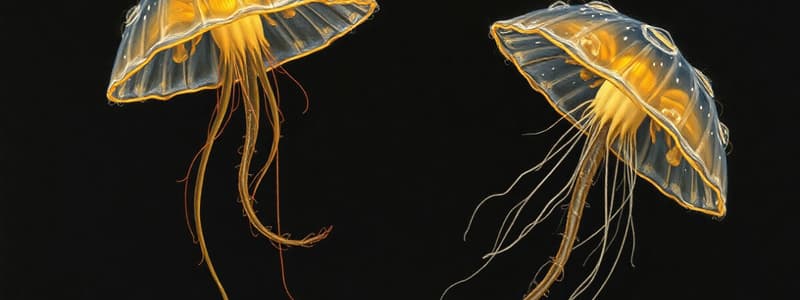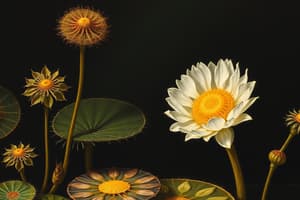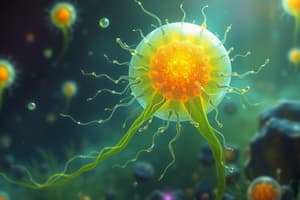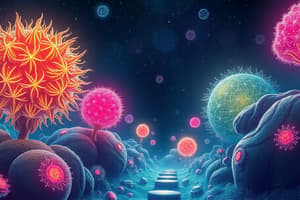Podcast
Questions and Answers
Which characteristic distinguishes protists from organisms in other kingdoms?
Which characteristic distinguishes protists from organisms in other kingdoms?
- Protists are unicellular organisms that do not fit neatly into other kingdoms. (correct)
- Protists are exclusively autotrophic.
- Protists always possess a true nucleus within their cells.
- Protists are exclusively multicellular.
How do sarcodines primarily move?
How do sarcodines primarily move?
- By coordinated beating of cilia.
- By contracting and expanding a contractile vacuole.
- Using flagella for propulsion.
- Through extensions of cytoplasm called pseudopodia. (correct)
What is the primary function of the contractile vacuole in some protists like Amoeba?
What is the primary function of the contractile vacuole in some protists like Amoeba?
- To digest engulfed food particles.
- To expel excess water from the cell. (correct)
- To store energy reserves for metabolism.
- To facilitate movement through the use of cilia.
How does Trypanosoma cause sleeping sickness?
How does Trypanosoma cause sleeping sickness?
How do ciliates, such as Paramecium, primarily move?
How do ciliates, such as Paramecium, primarily move?
What is the role of the red eye-spot in Euglena?
What is the role of the red eye-spot in Euglena?
Why is toxoplasmosis particularly dangerous for pregnant women?
Why is toxoplasmosis particularly dangerous for pregnant women?
What is the process called by which Amoeba engulfs food particles?
What is the process called by which Amoeba engulfs food particles?
What term describes protists that can produce their own food through photosynthesis?
What term describes protists that can produce their own food through photosynthesis?
Which protist-related disease is typically contracted by consuming contaminated water, leading to digestive system upset?
Which protist-related disease is typically contracted by consuming contaminated water, leading to digestive system upset?
Flashcards
Protists
Protists
Unicellular eukaryotic organisms that don't fit into other kingdoms.
Autotrophic Protists
Autotrophic Protists
Protists that make their own food.
Heterotrophic Protists
Heterotrophic Protists
Protists that depend on other organisms for food.
Flagellates
Flagellates
Signup and view all the flashcards
Sarcodines
Sarcodines
Signup and view all the flashcards
Ciliates
Ciliates
Signup and view all the flashcards
Binary Fission
Binary Fission
Signup and view all the flashcards
Contractile vacuole
Contractile vacuole
Signup and view all the flashcards
Cyst
Cyst
Signup and view all the flashcards
Amebic Dysentery
Amebic Dysentery
Signup and view all the flashcards
Study Notes
- Protists are unicellular organisms that do not fit into other kingdoms.
Characteristics of Protists
- They are always unicellular, made of one eukaryotic cell which functions as a whole.
- They can be autotrophic (make their own food), heterotrophic (dependent on other animals for food), or parasitic.
- They mostly live in water, soil or other organisms.
Classification of Protists
- Classified according to how they obtain nutrients and how they move.
- Animal protists, or protozoans ("small animals"), are heterotrophs.
- Plant-like protists, or unicellular algae, are autotrophs.
How Protists Move
- Flagellates move by flagella.
- Sarcodines move by extensions of cytoplasm (pseudopodia).
- Ciliates move by cilia.
- Sporozoans do not move.
Flagellates
- Move by one or two flagella.
- Absorb food across the membrane.
- Euglena is autotrophic, has chloroplasts and a red eye-spot for detecting light.
- Trypanosoma cause sleeping sickness, transmitted by the tsetse fly.
- Trichomonas causes trichomoniasis/inflammation of the vagina, is an STD (sexually transmitted infection), greenish vaginal discharge with a bad smell.
Sarcodines
- Move by pseudopodia ("false feet"), which are live extensions of cytoplasm creating ameboid movement.
- Ingest food by surrounding and engulfing (phagocytosis), creating a food vacuole.
- Reproduce by binary fission (mitosis).
- Have a contractile vacuole to remove excess water.
- Can cause amebic dysentery in humans (diarrhea and stomach upset) from consuming contaminated water.
- Ameoba lives in the gut of humans
- Foranniniferans and Radio lavians form shells.
Ciliates
- Paramecium is an example, move using cilia.
- Possess two nuclei: macronucleus (metabolism) and micronucleus (reproduction).
- Food is ingested through the cytostome (cellular mouth), forming a food vacuole.
- The anal pore (cellular anus) removes waste.
- Contractile vacuole removes excess water.
- Reproduce by binary fission or asexually through conjugation.
- They have a rigid outer membrane (pellicle) that gives them a consistent shape, like a shoe.
Sporozoans
- Do not move independently.
- Are endoparasitic, residing inside the body.
- Utilize both sexual and asexual reproduction and need multiple hosts; generate protective spore coats.
- Malaria: Caused by sporozoan (Plasmodium), affects the liver and blood and is transmitted by mosquitoes.
- Toxoplasmosis: Caused by a sporozoan (Toxoplasma), dangerous for pregnant women causing miscarriages, sources: excrement of cats and undercooked meat.
The Amoeba
- The ameba, a protozoan in the Kingdom Protista (phylum Sarcodina), changes shape; also sometimes called Amoeba.
- These animal-like protists move/creep by pushing cytoplasm creating fingerlike extensions called pseudopodia ("false foot.")
- The cell membrane is exceptionally flexible so it can change shape.
- Amoebas reside in ponds, puddles, and can also exist inside people.
- The darker, inner cytoplasm is called endoplasm, and the clearer cytoplasm closer to the cell membrane is called ectoplasm
- The ameba consumes food when the pseudopodia extend to wrap around it which is called phagocytosis; the food becomes a food vacuole which will be disposed via lysosomes.
- It reproduces through mitosis and divides into two identical new cells, which is called binary fission.
- Contractile vacuole pump out excess water.
- Amoebas create cysts (hard wall body) in harsh conditions.
- Consuming contaminated water can lead to contracting Amebic Dysentery causing cramps and diarrhea.
Studying That Suits You
Use AI to generate personalized quizzes and flashcards to suit your learning preferences.




